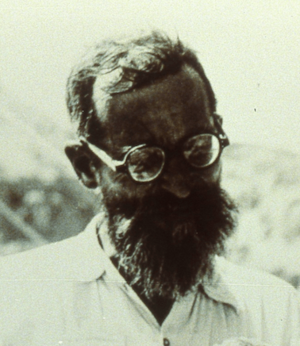Roland de Vaux facts for kids
Roland Guérin de Vaux (born in 1903, died in 1971) was a French priest from the Dominican Order. He became a very important person in the study of the Dead Sea Scrolls. These are ancient texts found near the Dead Sea. De Vaux led the team that first worked on these scrolls. He was also the director of the Ecole Biblique, a French Catholic school in East Jerusalem. His team dug up the ancient site of Khirbet Qumran and several caves nearby.
Contents
About Roland de Vaux
Roland de Vaux was born in Paris in 1903. He became a priest in 1929 and joined the Dominican Order that same year. From 1934 until he passed away in 1971, he lived in Jerusalem. He studied and later taught history at the École Biblique. From 1938 to 1953, he was the editor of a magazine called Revue Biblique.
He became very interested in archaeology, which is the study of ancient things. He learned a lot from other famous archaeologists like William F. Albright and Kathleen Kenyon. In 1945, he became the director of the École Biblique. He held this job until 1965.
In 1956, de Vaux became the main editor for the Dead Sea Scrolls. He was in charge of publishing the first five books of Discoveries in the Judaean Desert. This was the official publication for the scrolls. He continued this important work until his death in 1971.
Discovering Ancient Sites
Roland de Vaux worked on several archaeological digs. In 1947, he was asked to check out a cave near the Dead Sea. Some ancient scrolls had been found there. This cave later became known as Cave 1. It was the first cave to give up texts that became the famous Dead Sea Scrolls.
De Vaux started digging at the nearby Qumran ruins in December 1951. He led five seasons of excavations there. Besides Qumran, he also worked at other sites. These included Wadi Murabba'at in 1952 and 'Ein Feshkha in 1958. He also regularly returned to Tell el-Far'ah (north) from 1946 to 1960.
As de Vaux worked at Qumran, more scrolls were found. These discoveries brought a small group of young scholars to study them. These experts included Józef Milik and John Marco Allegro. Some of them worked on their assigned scrolls for many decades. From 1961 to 1963, de Vaux also worked with Kathleen Kenyon on digs in Jerusalem.
De Vaux did not publish a final report on his work at Qumran. However, he left behind many notes. These notes were later put together and published by Jean-Baptiste Humbert.
Important Books
Besides writing many articles for Revue Biblique, de Vaux is famous for two main books.
Archaeology and the Dead Sea Scrolls
In 1959, de Vaux gave some important talks at the British Academy. In these talks, he shared what he had learned from digging at Qumran. His main ideas included:
- The Qumran site was used from about 135 BCE until after 73 CE. It had three main periods of people living there.
- The caves where the scrolls were found were connected to the Qumran settlement. They had similar ancient objects.
- The site was home to a Jewish group called the Essenes. The scrolls often matched what was known about the Essenes from ancient historians.
These talks were later published as the book Archaeology and the Dead Sea Scrolls.
Ancient Israel
De Vaux also wrote a two-volume set called Ancient Israel. Volume 1, published in 1958, was about "Social Institutions." Volume 2, published in 1960, was about "Religious Institutions." In these books, de Vaux wrote a lot about what archaeology showed about ancient Israel.
See also
 In Spanish: Roland de Vaux para niños
In Spanish: Roland de Vaux para niños


